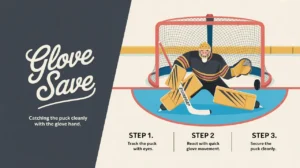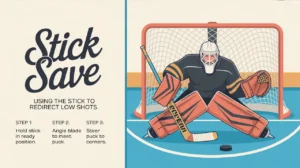Jim’s Intro to Lateral Movement
Hi folks, Jim here, the only commentator who once tried a lateral push in net and slid so far I nearly ended up on the freeway.
What is lateral movement?
Lateral movement is a goaltending technique where the goalie moves side to side quickly and efficiently across the crease to stay in position as the puck changes location. It’s essential for handling cross-ice passes, rebounds, and quick puck movement in the offensive zone.
How does it work?
Lateral movement depends on edge control, stance, and explosive pushes:
- Athletic Stance: Start balanced, with knees bent and weight slightly forward.
- Push Off Inside Edges: Drive laterally using strong pushes from the skate’s inside edge.
- T-Push vs. Shuffle: Use T-pushes for longer, explosive moves and shuffles for short adjustments.
- Square to the Puck: Rotate your body so you remain facing the shooter throughout the movement.
- Butterfly Integration: Combine lateral movement with drops and recoveries to stay sealed.
- Controlled Stops: Finish each push balanced and ready, not sliding out of position.
How do you make good decisions with it?
- Read the Play Early: Anticipate cross-ice passes or puck movement to move with purpose.
- Pick the Right Technique: Shuffle for minor adjustments, T-push for bigger gaps.
- Stay Centered: Don’t over-slide past the puck’s line of attack.
- Control Speed: Moving too fast can open holes; moving too slow leaves you exposed.
- Recover Quickly: After each movement, reset for the next potential shot.
How do you master it?
Mastering lateral movement takes edgework drills, strength training, and repetition. Goalies work on controlled shuffles, explosive T-pushes, and integrating movement into game-speed scenarios. Strong legs and flexible hips are essential for smooth transitions.
What does it look like when done right?
Great lateral movement looks smooth and effortless. The goalie slides or pushes across the crease in sync with the puck, sets square, and is ready before the shot arrives.
Commentator’s Corner
Jim’s Take
Good lateral movement is like watching a sliding door close just in time. The puck swings cross-ice, and boom, the goalie’s there like they teleported.
Parent Tip
Prioritize skating and edgework for goalies early. Strong lateral movement prevents desperation saves later.
Player Tip
Goalies, work on both power and control. Shooters, know that a goalie with elite lateral movement makes cross-ice passes much less dangerous.
A Final Thought
Lateral movement is the heartbeat of modern goaltending. Master it, and you’ll track the puck across the crease with precision, turning high-danger chances into routine stops.









